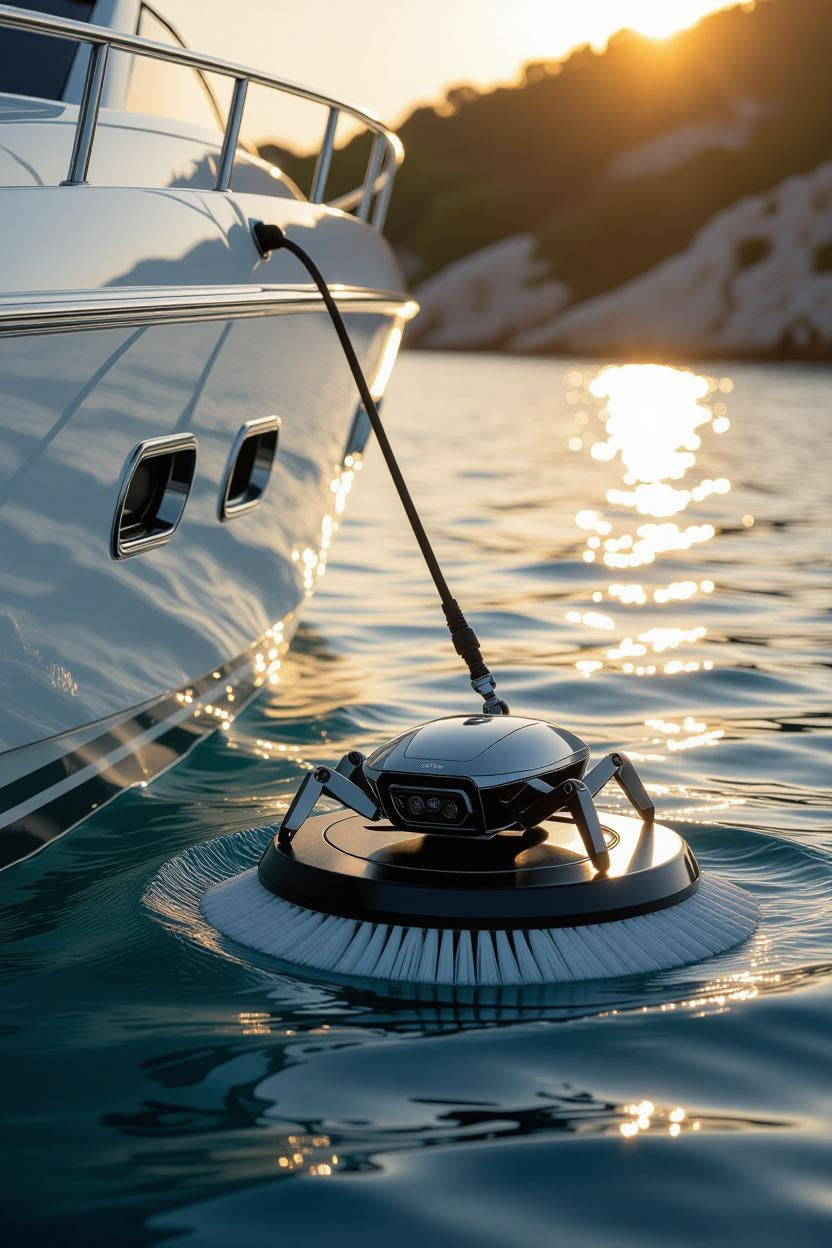The Robotic Revolution: How Hull Cleaning Bots Will Eradicate Anti-Fouling Paints by 2030
Dear Evolve Community,
Imagine a world where your boat glides through the water effortlessly, free from the drag of stubborn barnacles and algae, without a single drop of toxic paint coating its hull. Sounds like science fiction? It's not—it's the near future of marine maintenance, and at Evolve Robotic Hull Cleaning, we're at the forefront of making it a reality. Drawing inspiration from a humble backyard innovation that transformed an entire industry, we're poised to revolutionize how we care for our vessels. Let's dive in.
The Pool Cleaning Revolution: A Blueprint for Change
Cast your mind back to the 1970s, when pool ownership was synonymous with endless scrubbing, chemical cocktails, and back-breaking labor. Enter the "Kreepy Krauly"—affectionately known as the creepy crawler—a simple yet ingenious robotic device that automated the drudgery of pool cleaning. This suction-powered bot, invented by South African engineer Ferdinand Chauvier, crawled along pool floors and walls, sucking up debris and algae with relentless efficiency. It didn't just clean; it liberated homeowners from manual toil.
Before the creepy crawler, pools relied heavily on harsh chemicals and frequent draining to combat buildup. Algae blooms turned crystal-clear waters into murky messes, and the environmental toll was immense—chlorine runoff polluting waterways, and energy wasted on inefficient filtration. But the Kreepy Krauly changed everything. By the 1980s, it had become a household staple, reducing chemical dependency by up to 50% in many cases and slashing maintenance time dramatically. Today, robotic pool cleaners are ubiquitous, with advanced models using AI to map pools, avoid obstacles, and even self-empty. The industry shifted from reactive, chemical-heavy approaches to proactive, eco-friendly automation. Pools became self-sustaining ecosystems, and the creepy crawler proved that technology could outpace tradition.
Now, fast-forward to the marine world. Boat hulls face a similar foe: biofouling—the relentless accumulation of marine organisms that increases drag, boosts fuel consumption, and accelerates wear. Traditional anti-fouling paints, laden with biocides like copper and tributyltin (TBT), have been the go-to defense for decades. But like those old-school pool chemicals, they're a double-edged sword: effective in the short term, but environmentally devastating. These paints leach toxins into oceans, harming marine life, contaminating sediments, and even entering our food chain. Regulations are tightening—remember the global ban on TBT in 2008?—yet fouling persists, costing the shipping industry billions in fuel inefficiency alone.
Enter Robotic Hull Cleaning: The Marine Equivalent of the Creepy Crawler
At Evolve Robotic Hull Cleaning, we're channeling that same transformative spirit with our state-of-the-art Keelcrab underwater drones. These autonomous robots aren't just tools; they're game-changers. Capable of cleaning 95-97% of displacement hulls and 85-87% of planing or semi-planing vessels (for boats 10-24 meters long), our Keelcrab bots gently remove coral, vegetation, and algae without stripping away underlying surfaces. As we highlight on our site, "Our brushes are designed to remove principles of coral, vegetation and algae without removing the underlying antifouling." This means your boat stays sleek and efficient, all while we come to you—wherever you're moored in Sydney Harbour, the Gold Coast, or Cairns.
The benefits are profound and multifaceted. For starters, regular robotic cleanings can save you thousands annually on fuel, as a clean hull reduces drag by up to 20%. Our VIP membership, starting at just $2.69 per day, offers "Low Cost, Hassle Free Maintenance," ensuring year-round care that's less than the price of your morning coffee. Environmentally, it's a win-win: by preventing heavy fouling buildup, we minimize the need for those toxic paints that poison our seas. As we passionately state, "At Evolve Robotic Hull Cleaning, we're passionate about revolutionising boat maintenance with innovative, eco-friendly solutions like the Keelcrab underwater drone." Performance-wise, your vessel operates at peak efficiency—no more "dog teeth" barnacles slowing you down or forcing costly haul-outs.
But here's where it gets truly exciting: just as the creepy crawler evolved from a basic suction device to smart, app-controlled marvels, robotic hull cleaning is on the cusp of exponential advancement. Today's Keelcrab is already a leap forward, but integrate AI, enhanced sensors, and autonomous docking systems, and we're talking about vessels that clean themselves on the go.
The Bold Prediction: Anti-Fouling's Days Are Numbered
Mark my words: within the next five years, robotic hull cleaning will render traditional anti-fouling paints obsolete for all vessels. Why? The technology is scaling rapidly. Advances in battery life, materials science, and machine learning mean bots like ours will soon handle even the toughest fouling—barnacles included—without human intervention. Imagine fleets of micro-drones patrolling hulls in real-time, zapping growth with ultrasonic waves or biodegradable enzymes, all powered by solar-charged stations at marinas.
This isn't hype; it's extrapolation from proven trends. Pool cleaning went from manual brushes to full automation in under a decade. Marine tech is following suit, driven by stricter environmental laws (like the IMO's biofouling guidelines) and economic pressures. Fuel savings alone could offset costs—studies show fouled hulls increase consumption by 10-40%, translating to millions for commercial ships and hundreds for recreational boaters. At Evolve, we're already demonstrating this with our one-off express cleanings and pre-purchase inspections, proving that proactive robotics outperform passive paints.
And the environmental imperative? Anti-fouling toxins have decimated coral reefs and fish populations. Robotics offer a clean alternative: no leachates, no pollution, just pure efficiency. As leaders in this space, we're committed to "pushing the boundaries of what's possible in marine maintenance," ensuring our oceans thrive alongside our adventures.
Advocating for Self-Cleaning Vessels: Our Mission with Manufacturers
I'm thrilled to share that here at Evolve, we're not just servicing boats—we're shaping the industry. I'm actively engaging with boat manufacturers to champion integrated robotic systems. Picture this: by the end of the decade, new vessels could come equipped with built-in cleaning modules—drones that deploy automatically, much like a car's self-washing wipers but for hulls. These self-cleaning boats would eliminate fouling at the source, extending hull life, slashing emissions, and making boating truly sustainable.
We've initiated discussions with key players, showcasing data from our Keelcrab deployments: faster speeds, lower maintenance, happier owners. It's a paradigm shift, and we're leading the charge. If you're a manufacturer reading this, let's talk—book a free demo at evolverobotichullcleaning.com/products/book-a-demo and see the future firsthand.
Join the Evolution
The creepy crawler didn't just clean pools; it redefined leisure. Similarly, robotic hull cleaning isn't about spot treatments—it's about liberating you to enjoy the open water without worry. At Evolve, we're bringing this future to your berth today. Whether through our memberships, express services, or simply a conversation about what's next, we're here to evolve with you.
Ready to ditch the paints and embrace the bots? Visit www.evolverobotichullcleaning.com to learn more, book a service, or sign up for our VIP program. The revolution is underway—don't get left in the wake.
Fair winds and clean hulls, Evolve Robotic Hull Cleaning



Share:
Hull By Hull
Evolve Robotic Hull Cleaning Newsletter